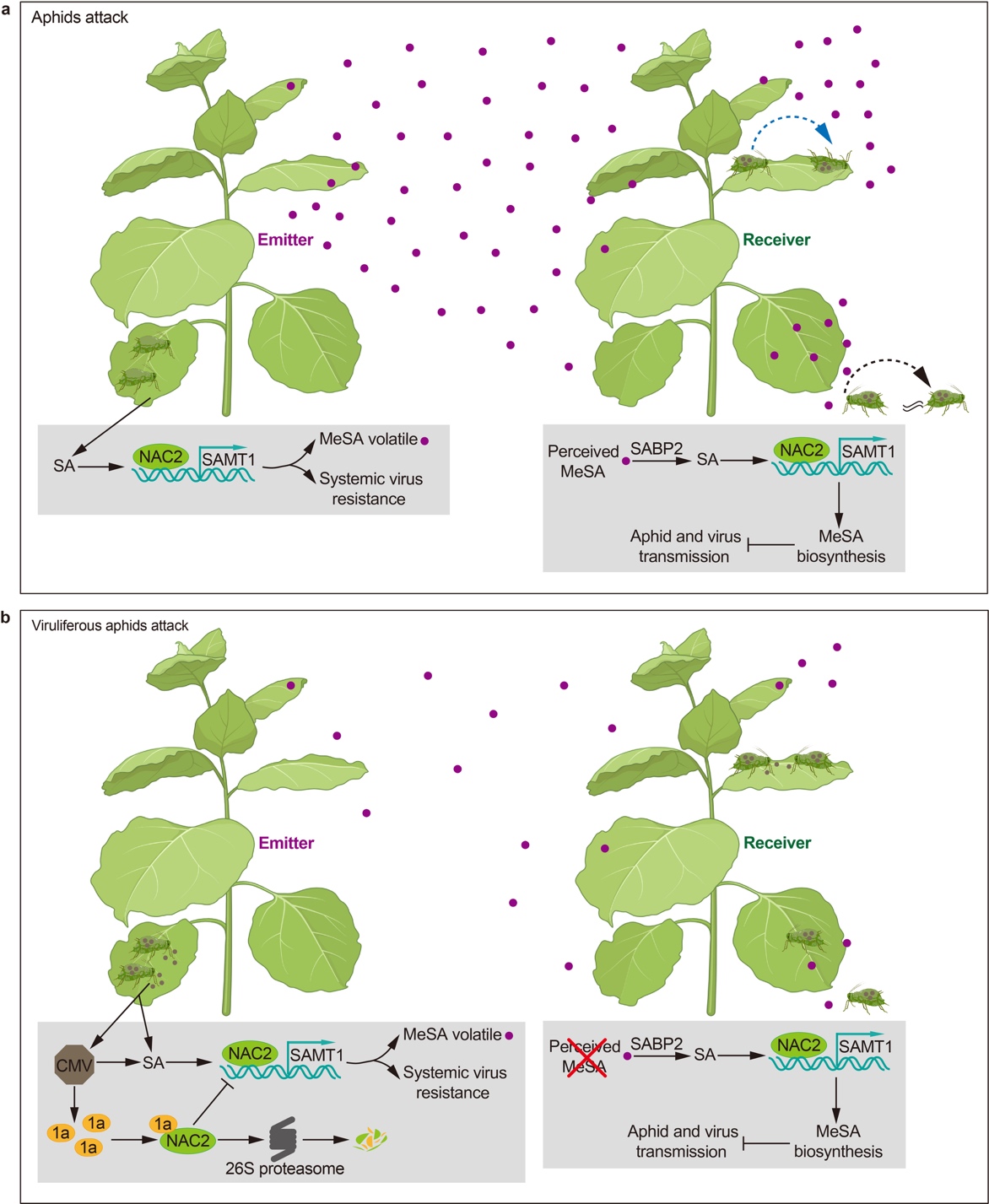When plants are exposed to environmental stimuli, they produce volatile organic compounds (VOCs). These VOCs can be perceived by neighboring plants triggering defensive responses. This phenomenon is known as airborne defense (AD). Such plant-plant communication (PPC) and its biological and ecological significance have been observed in many species over decades. However, molecular genetic framework for the VOC-mediated PPC including AD is largely unknown. Moreover, with the exception of the receptor for ethylene, the receptors for mediating VOC-sensing system in plants have remained unidentified. Aphids are the most destructive agricultural and horticultural pests worldwide. They are phloem-feeding and cause extensive destruction to crop production due to their efficient transmission of more than 40% plant viruses. Aphid-attack induces plant emitting VOCs which are mainly composed of MeSA. MeSA has been implicated in plant defense against herbivorous insects including aphids by repelling, attracting predators, or reducing survival fitness of these insects. However, how MeSA serves as an interplant communication signal to activate anti-aphid defense in neighboring ‘receiver’ plants has been a long-standing and unsolved question. For instance, whether plants possess receptor systems to sense and perceive airborne MeSA is unclear. Furthermore, it remains to be elucidated whether and how aphids and viruses can regulate AD.
On September 13, 2023, a research team led by Prof. Liu Yule published their research paper online in Nature titled "Molecular Basis of Methyl Salicylate-Mediated Plant Airborne Defense." This work identified SABP2 as a plant receptor for perceiving airborne MeSA, and revealed the molecular mechanism of MeSA-mediated plant airborne immunity as well as viruses` counter-defense mechanism. It provides new insights and research directions for disease and pest control.
Most plant viruses rely on intermediaries such as insects for transmission. Upon insects’ infestation, plants produce VOCs to repel the insects and attract insects` natural enemies. Additionally, VOC can serve as aerial cues and be perceived to elicit defenses in neighboring ‘receiver’ plants. The Liu Yule group reported that aphid-attack induces plant MeSA production, and airborne MeSA is perceived and converted to SA by SABP2 in neighboring plants. SA then cascades signal transduction to activate the NAC2-SAMT1 module for MeSA biosynthesis to induce neighboring plants anti-aphid immunity and reduce virus transmission. Moreover, Liu Yule group also found that some aphid-transmitted viruses, such as cucumber mosaic virus and potato Y virus, encode proteins with helicase domains that interact with the NAC2 protein. This interaction alters the subcellular localization of NAC2, promoting NAC2 retained in the cytoplasm and degraded by the 26S proteasome system, subsequently negatively regulating MeSA mediated airborne defense (Figure 1). This study reveals the detailed molecular basis of plant airborne immunity and the counter-defense mechanism of viruses, shedding light on a novel mutualistic coevolution between aphids and viruses.
The corresponding author is Prof. Liu Yule of Tsinghua University. The first authors are Postdoctoral researchers Gong Qian and Wang Yunjing of Tsinghua University. Prof. Hong Yiguo of Hebei Agricultural University, PhD candidates He Linfang and Huang Fan, Dr. Zhang Danfeng (former Postdoctoral researcher in Tsinghua University), Dr.Wang Yan (Research Associate in Tsinghua University), Dr. Wei Xiang (Senior Engineer in Tsinghua University), Prof. Deng Haiteng and Han Meng of Tsinghua University, Researcher Feng Cui and engineer Luo Lan of the Institute of Zoology, Chinese Academy of Sciences have made significant contributions to this research. In addition, we have received valuable advice and assistance from Prof. Kang Le of the Institute of Zoology, Chinese Academy of Sciences, Prof. Wang Xianbing of China Agricultural University, Prof. Li Xiangdong of Shandong Agricultural University, Researcher Guo Huishan, Researcher Ye Jian, and Dr. Zhao Pingzhi. of the Institute of Microbiology, Chinese Academy of Sciences. This work was supported by the grants including National Key Research and Development Program of China and the National Natural Science Foundation of China.

Figure 1. A Model of Interplant Communication Mediating Airborne Defense against Aphids and Viruses
Editor: Li Han

